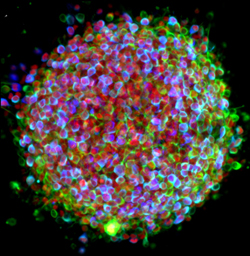Can you patent a gene? What about a cell? When it comes to the components of life, and more importantly the ideas, processes, and procedures developed to manipulate these components, what belongs to who? This is a question that is certainly going to be fought out from the patent office to the courts as more and more biomedical discoveries are made.
One discovery that has recently (meaning August) been in the news for patent applications is Shinya Yamanaka’s 2006 discovery of the combination of genes that can be used to reprogram adult cells to a pluripotent (capable of becoming any kind of cell) state. With these induced pluripotent stem cells (iPSCs) lies the hope of a suitable answer to the debate over the need for pluripotency, but the social and religious controversy over using human embryonic stem cells (which are naturally pluripotent).
While working at Kyoto University in Japan, Yamanaka found that the genes Oct3/4, SOX2, c-Myc, and Klf4 are key to pluripotency. This discovery led to the creation of the first iPSCs. Now, five years and millions of dollars in research later, Kyoto University has obtained patent rights for iPSC technology in six nations and two regions, including the United States. This development leads me back to the question I started with, can you patent a gene? What about the ideas or technology based on those genes? Apparently, you can because Kyoto University has. But, I’m still quite curious about how this will play out functionally.
The discovery of iPSCs was huge news. It prompted researchers around the world to start working with iPSCs, many of whom have subsequently made their own discoveries, published their own research in peer reviewed journals (just type pluripotent into PubMed you’ll see what I mean), and expanded greatly on the existing body of knowledge about pluripotency. This includes the discovery of numerous variations of gene combinations that play a role in pluripotency. So if Kyoto University owns the original idea, do they own everyone elses’ work too? According to university spokeswoman Akemi Nakamura, they do. Nakamura says the patent broadly covers variations of the technology developed since 2006 in laboratories around the world.
In a press release the University stated:
“The US patent covers combinations of nuclear reprogramming family factors comprising an Oct family gene, a Klf family gene, and Myc family gene; or an Oct family gene, a Klf family gene, and a cytokine. This means that if companies use a combination of the nuclear reprogramming genes and generate iPSCs, regardless of the kinds of vectors, they need to get the patent license.”
So if Kyoto University owns the right to the genes, and the subsequent developments based on the genes what does that mean for iPSC researchers? Right now the university says it will not restrict research using iPSCs for non-profit purposes, so that would mean research whose end goal isn’t the marketing of a specific product based on iPSC technology will be able to continue unhindered. Companies that want to work with iPSCs for profit may have to pay a licensing fee. Although, it is important to note that not all iPSC research is based on these genes – there are other combinations of genes that can induce pluripotency, and thus lines of inquiry in this field that don’t belong to Kyoto University.
How important all of this will be, and when it will be important is a bit murky. iPSCs have their own problems (namely, teratomas) and haven’t yet been developed for widespread, let alone commercial, use. Though, with all of the resources being poured into iPSC development, I think it is only a matter of time until the cells become more useable. This is a story to watch, it is hard to say exactly how it will work out but it is sure to be an issue that continues to come up.
As for me, I’m not really sure where I fall on this issue. I can see the need to protect intellectual achievements and make sure that the wrong people don’t profit, but at the same time I wish it wasn’t necessary and open inquiries could be pursued without people having to worry about others cashing in on their ideas. If only it could be that way.


